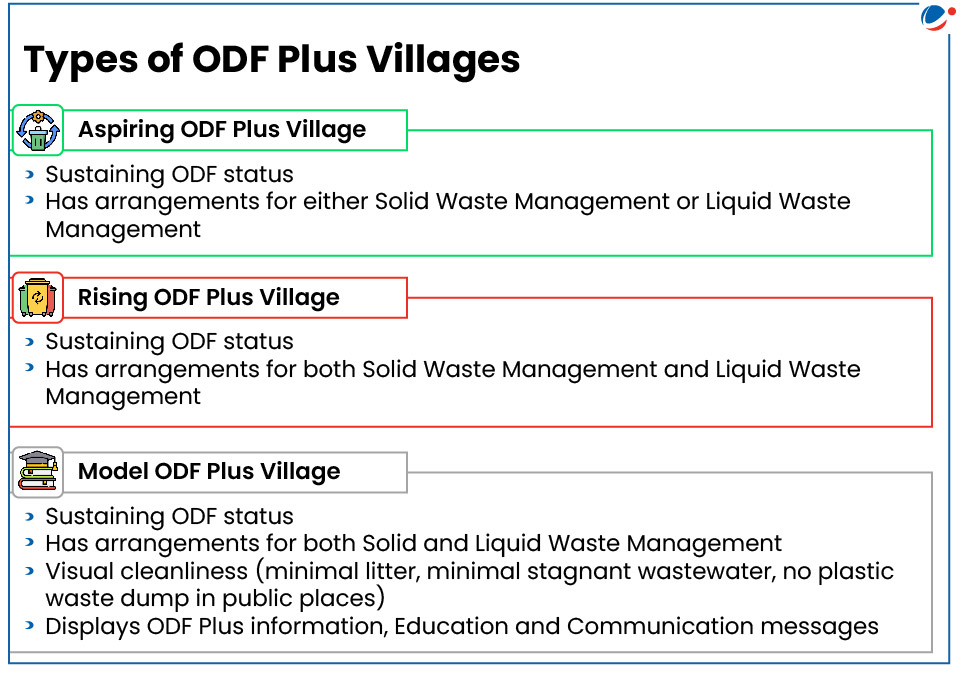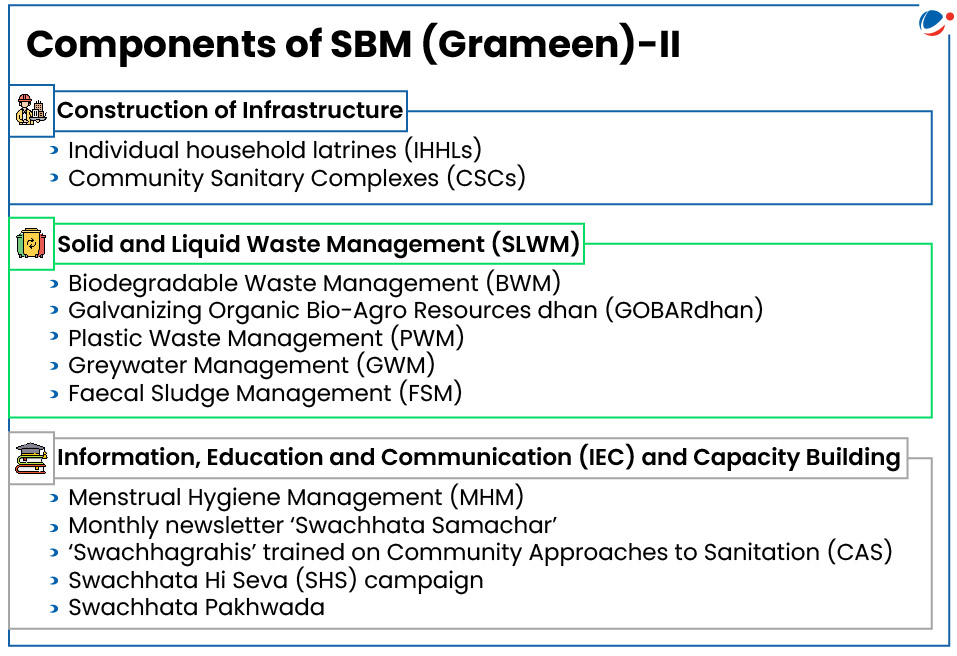Why in the News?
The Standing Committee on Water Resources published a report analysing the implementation of Swachh Bharat Mission-Grameen.
About Swachh Bharat Mission- Grameen
- A centrally sponsored scheme, launched in 2014 to achieve comprehensive sanitation coverage in rural areas.
- Objectives of SBM-G:
- Phase-I (2014-2019): To make the country Open Defecation Free (ODF) by October 2, 2019, the 150th birth anniversary of Mahatma Gandhi, by providing access to toilets to all the rural households.
- Phase-II (2019-2025): Launched in 2020 to ensure Sampoorn Swachhata, that is, no one is left behind in their pursuit for having Individual Household Toilets and proper waste management systems, making villages ODF Plus Model.
- ODF Plus Model includes: -
- ODF Sustainability
- Solid Waste Management
- Liquid Waste Management
- Visual Cleanliness

- Key features
- Funding pattern:
- 60:40 between Centre and States for all components
- 90:10 in case of North Eastern States and Himachal Pradesh, Uttarakhand and UT of Jammu & Kashmir
- Other UTs: 100% share is borne by Centre.
- Incentive of Rs.12000/-: For construction of individual household latrine (IHHL) for all BPL households and identified Above Poverty Line (APL) household (SC/ST households, households with physically disabled person, landless labourers with homestead, small and marginal farmers and women headed households)
- Jan Aandolan model: It is considered as the largest mass movement and behavioral change programme in the world.
- Swachh Survekshan Grammen (SSG): A yearly survey conducted through a third-party survey agency.
- Swachhata Hi Seva (SHS) 2024 campaign: To reignite the spirit of collective action and citizen participation in cleanliness efforts across India.
- Funding pattern:

Progress and Achievements
- Impact of Phase-I
- By October 2019, all villages across the country in all 36 States/UTs declared themselves ODF.
- Rural sanitation coverage: Increased from 39% in 2014 to 100% in 2019.
- Health: SBM helped avoid 3 lakh diarrheal deaths in 2019 compared to 2014. (WHO)
- Nutrition and productivity: Cases of wasting among children are 58% higher in non-ODF areas (The Bill & Melinda Gates Foundation).
- Safety and dignity of women: 93% women feel safer after getting a toilet at home. (UNICEF)
- Savings in health expenditure: An average of ₹50,000 was being saved every year by families in ODF villages, due to health costs avoided. (UNICEF)
- Achievements of Phase-II
- 5,57,468 villages out of 5,87,529 villages (~95%) have been declared ODF Plus.
- According to the SBM-G Dashboard (March, 2025):
- ODF-Plus Model States / UTs: Sikkim and Lakshadweep
- ODF-Plus States / UTs: Ladakh
- More than 5 lakh villages have arrangements for both Solid and Liquid Waste Management.
Challenges in Implementation (Standing Committee on Water Resources)
- Underperformance: Slow Progress during last 5 years hinders achieving targets-
- Only 35% and 57% targets were achieved in SWM (Solid Waste Management) and LWM (Liquid Waste Management) respectively.
- Only 56% targets in respect of ODF Plus (Model) villages achieved.
- Only 31% and 8% targets were achieved in Individual Household Latrines (IHHLs) and Community Sanitary Complexes (CSCs) respectively.
- Underutilization of allocated funds: Only 19.61% of the allocated budget is utilized in the current FY 2024-25.
- Reliance on Extra Budgetary Resources (EBR): Substantial portion of the budgetary allocation (9-17%) had been spent on payment of interest on EBR during the last 5 years thereby reducing the availability of funds for effective utilization.
- Inadequate incentive: The BPL section is given an incentive of ₹12,000 for construction of IHHL which is found to be inadequate as it is based on 2014 assessment.
- Functional Assessment: SSG-2023 has issues like- inadequate scale (small sampling), doubtful credibility of the third-party survey agency and the methodology used etc.
- Regional disparity: States/UTs like Manipur, Meghalaya, Jharkhand, Punjab and Nagaland are lagging behind in achieving SWM saturation.
- Others: Insufficient availability of vehicles for Sanitation services in States/UTs; Low coverage of blocks with Plastic Waste Management Units (PWMUs); Lack of a new baseline survey to identify the leftout households etc.
Recommendations (Standing Committee on Water Resources)
- Fast-track implementation through coordinated efforts with States/UTs needed to identify and address issues faced in achieving Mission goals.
- Fully utilize the allocated budget in a time-bound manner and prepare a road map for prudent utilization/release of funds.
- Avoid raising funds through EBR as it leads to payment of substantial interest.
- Reviewing and revising the incentive for IHHLs based on present rate of inflation.
- Devise Comprehensive monitoring mechanism to accurately assess the functionality of key ODF Plus parameters.
- Improve Solid and Plastic Waste Management by augmenting activities like increasing number of sanitation vehicles, development of forward linkage for plastic waste management and increasing number of functional PWMUs.



